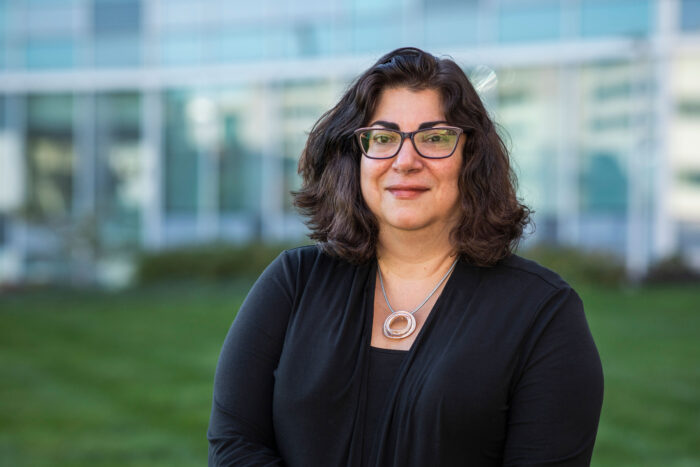Woodard named head of Department of Radiology
Cardiothoracic imaging expert brings strengths in research, education, leadership
 Mallinckrodt Institute of Radiology
Mallinckrodt Institute of RadiologyPamela K. Woodard, MD, a national leader in cardiothoracic imaging, has been named head of the Department of Radiology, director of Mallinckrodt Institute of Radiology (MIR) and the Elizabeth E. Mallinckrodt Professor of Radiology at Washington University School of Medicine in St. Louis. She will begin her new role July 1.
Pamela K. Woodard, MD, a national leader in cardiothoracic imaging, has been named head of the Department of Radiology, director of Mallinckrodt Institute of Radiology (MIR) and the Elizabeth E. Mallinckrodt Professor of Radiology at Washington University School of Medicine in St. Louis. She will begin her new role July 1.
In this new role, she will leverage her extensive research, clinical and leadership experience in the field of radiology. She is currently the Hugh Monroe Wilson Professor of Radiology, senior vice chair and division director of MIR’s Radiology Research Facilities, director of the Center for Clinical Imaging Research, head of Advanced Cardiac Imaging CT/MRI, director of the Radiology Research Residency Program, and director of TOP-TIER, a clinician-scientist training program for residents and fellows.
“Dr. Woodard was unanimously selected by our leadership team from a deep and impressive group of candidates,” said David H. Perlmutter, MD, executive vice chancellor for medical affairs, the George and Carol Bauer Dean of the School of Medicine, and the Spencer T. and Ann W. Olin Distinguished Professor. “We believe she can lead us in further defining the career of radiologists and imaging scientists, the role of imaging in personalized medicine, and new strategies for diagnosis and treatment through interventional, minimally invasive and even noninterventional approaches that will advance human health. Her experience in collaborative work with other clinical and preclinical departments is an essential ingredient of the virtuous cycle of academic medicine that exemplifies the partnership of WashU Medicine and BJC HealthCare.”
Also a professor of medicine, of pediatrics and of biomedical engineering, Woodard conducted seminal research that led to the translation of cardiac magnetic resonance imaging (MRI) into clinical practice, including methods to improve imaging quality by suppressing respiratory motion. Such methods are in use in pediatric cardiac and congenital heart imaging.
She also led a team that developed a nanoparticle-based imaging agent for atherosclerotic plaques in blood vessels. The imaging agent detects a protein associated with unstable plaques that are prone to causing sudden major problems such as a heart attack or stroke.
Woodard is involved in the translation of novel positron emission tomography (PET) agents to assess blood flow through heart muscle. Poor blood flow is a sign of cardiovascular disease that could cause serious problems such as heart attacks. Her work led to the development of an imaging approach now widely used to assess blood flow through heart muscle, crucial information that doctors use to determine optimal treatment for each patient.
Woodard’s early work involved novel approaches to imaging blood clots in the lungs. In 1995, as a resident at Duke University, she published one of the early papers showing that such clots could be detected by multidetector spiral CT scan, then a developing technology. This type of CT scan uses an array of detectors to acquire multiple images simultaneously. Later, as an assistant professor at Washington University, she was a principal investigator on a clinical trial funded by the National Institutes of Health (NIH) that resulted in a landmark paper in The New England Journal of Medicine and established multidetector CT as the standard of care for diagnosing blood clots in the lungs.
The Department of Radiology is a world leader in radiological innovations that advance the science of imaging to improve patient care and further biomedical research. It has a long history of national leadership in the practice and science of radiology, and in educating the next generation of radiologists and radiology researchers.
“I am honored to serve and lead Mallinckrodt Institute of Radiology at Washington University School of Medicine in this important role,” Woodard said. “The Department of Radiology has a long tradition of excellence and innovation in clinical radiology, radiology education, and imaging research. I am delighted to lead our world-class faculty and trainees in radiology into the next decade in collaboration with our partners at BJC HealthCare and across the Medical Campus.”
Woodard earned her bachelor’s and medical degrees at Duke. She completed her internship in internal medicine at the University of North Carolina at Chapel Hill and her residency in radiology at Duke before coming to Washington University for a clinical fellowship in cardiothoracic radiology. She joined the School of Medicine faculty in 1997.
She is a fellow of the American Association for the Advancement of Science, the American Institute for Medical and Biological Engineering, the American College of Radiology and the American Heart Association. She serves on the Board of Chancellors for the American College of Radiology, the Executive Committee of the Board of the Academy for Radiology and Biomedical Imaging Research, and the Board of the Society for Cardiovascular Computed Tomography.
Woodard will succeed Richard L. Wahl, MD, who has led the department for nine years. Wahl will continue to lead a research laboratory as a professor in the department.
“Dr. Richard Wahl’s leadership has continued the strong tradition and legacy of Mallinckrodt Institute of Radiology and positioned the department for even greater potential in the future,” Perlmutter said. “Dr. Pamela Woodard is the ideal person to take on the mantle to take the department into the next era of foundational accomplishments.”







